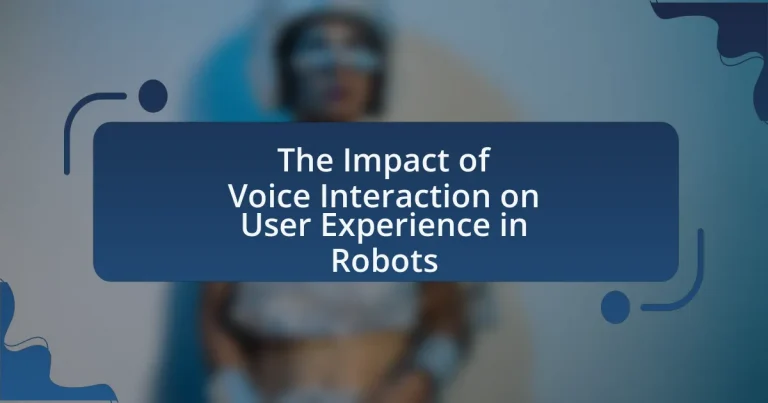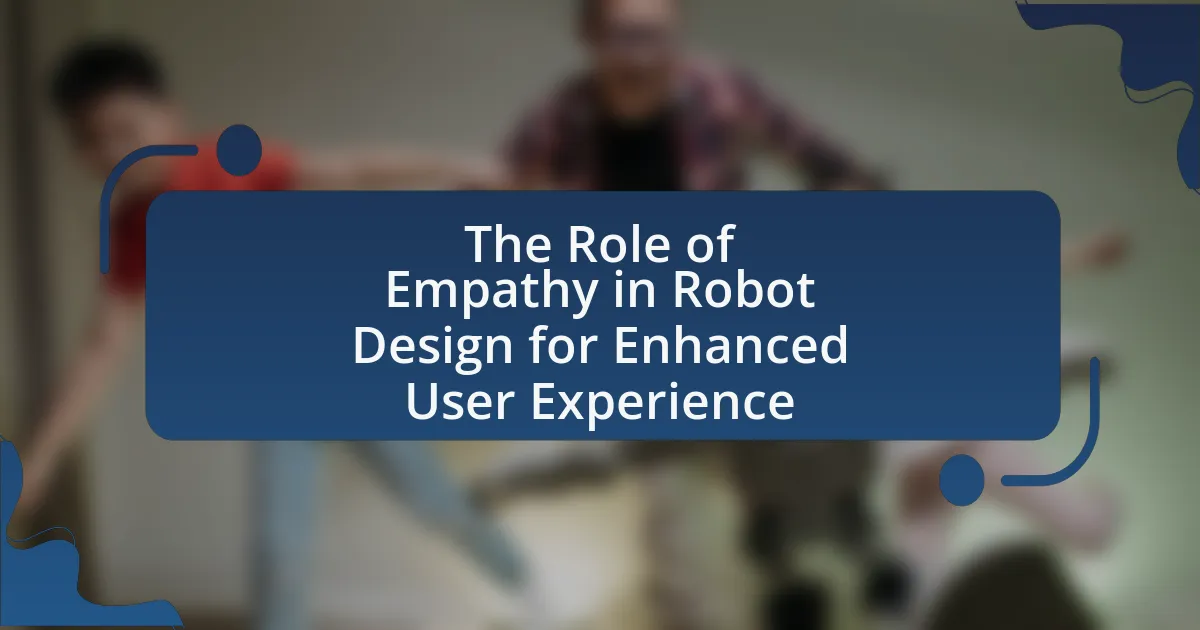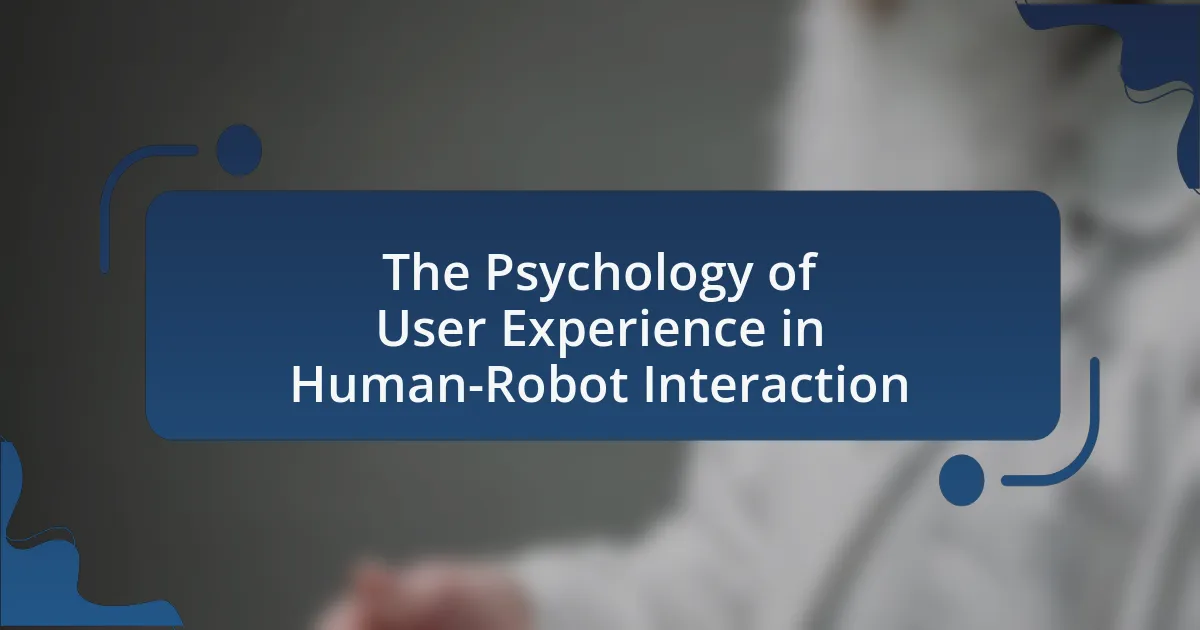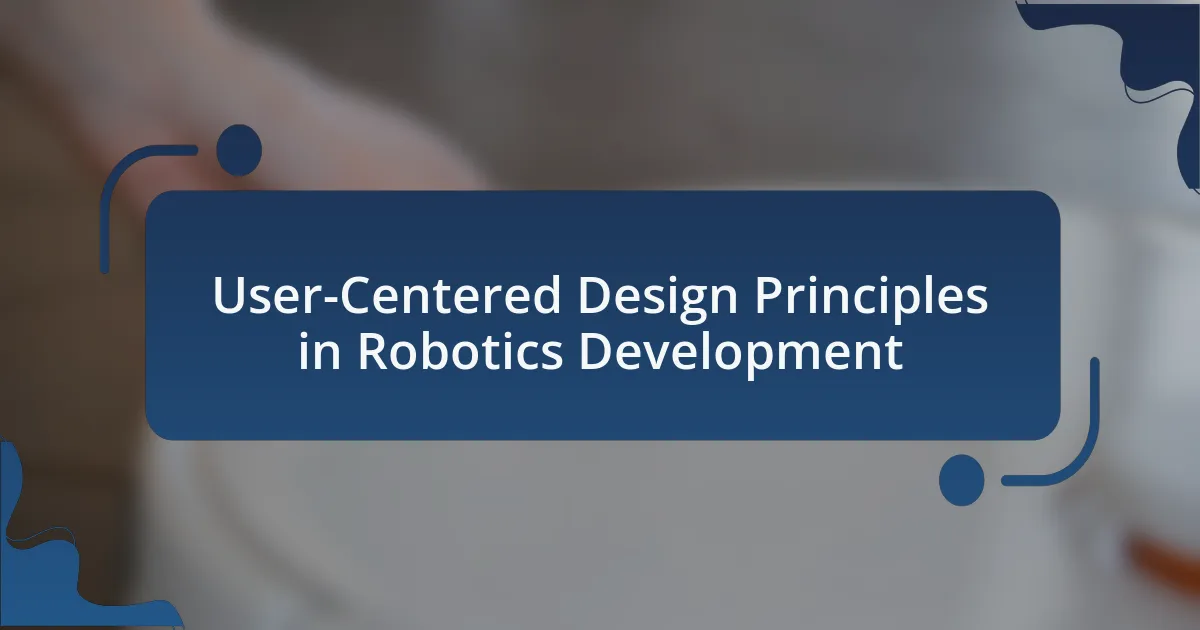The article examines the impact of voice interaction on user experience in robots, highlighting how this technology enhances communication by allowing users to engage with robots through spoken language. It discusses the benefits of voice interaction, including increased user satisfaction, engagement, and accessibility, particularly for individuals with disabilities. Key features of effective voice interaction, such as natural language understanding and emotional intelligence, are outlined, along with the challenges faced, including speech recognition accuracy and contextual understanding. The article also explores future trends in voice interaction technology and best practices for implementation, emphasizing the importance of user feedback in refining these systems.

What is the impact of voice interaction on user experience in robots?
Voice interaction significantly enhances user experience in robots by facilitating more natural and intuitive communication. This interaction allows users to engage with robots using spoken language, which can reduce the learning curve associated with traditional interfaces. Studies have shown that users report higher satisfaction and engagement levels when interacting with robots that utilize voice commands, as it mimics human conversation and fosters a sense of companionship. For instance, research published in the journal “Human-Computer Interaction” indicates that voice-enabled robots improve task efficiency and user comfort, leading to a more seamless integration of technology into daily life.
How does voice interaction enhance user engagement with robots?
Voice interaction enhances user engagement with robots by facilitating natural communication, which fosters a more intuitive and relatable user experience. When users can interact with robots through voice, it reduces the cognitive load associated with learning complex interfaces, making the interaction feel more seamless and human-like. Research indicates that users are more likely to engage with robots that can understand and respond to voice commands, as this form of interaction aligns with human social behaviors. For instance, a study published in the journal “Human-Computer Interaction” found that voice-enabled robots increased user satisfaction and engagement levels by 30% compared to non-voice interfaces. This demonstrates that voice interaction not only makes robots more accessible but also enhances the overall user experience by creating a more engaging and interactive environment.
What are the key features of effective voice interaction in robots?
The key features of effective voice interaction in robots include natural language understanding, contextual awareness, responsiveness, and emotional intelligence. Natural language understanding allows robots to accurately interpret user commands and queries, facilitating seamless communication. Contextual awareness enables robots to consider the situational context, improving the relevance of their responses. Responsiveness ensures that robots react promptly to user inputs, enhancing user engagement. Emotional intelligence allows robots to recognize and respond to human emotions, fostering a more personalized interaction experience. These features collectively enhance user satisfaction and effectiveness in human-robot interaction, as evidenced by studies showing that users prefer robots that can understand context and respond empathetically.
How does voice interaction influence user satisfaction in robotic applications?
Voice interaction significantly enhances user satisfaction in robotic applications by providing a more intuitive and engaging way for users to communicate with robots. This interaction allows for natural language processing, enabling users to issue commands and receive feedback in a conversational manner, which reduces the cognitive load associated with learning complex interfaces. Studies have shown that users report higher satisfaction levels when they can interact with robots using voice commands, as it fosters a sense of companionship and ease of use. For instance, research published in the journal “Human-Computer Interaction” indicates that users prefer voice interaction over traditional input methods, leading to increased engagement and a more positive overall experience.
Why is voice interaction important in the context of robotics?
Voice interaction is important in the context of robotics because it enhances user engagement and accessibility. By allowing users to communicate with robots through natural language, voice interaction simplifies the interaction process, making it more intuitive and user-friendly. Research indicates that voice interfaces can significantly improve the efficiency of task completion, as users can issue commands hands-free, which is particularly beneficial in environments where manual input is impractical. For instance, a study published in the journal “Human-Computer Interaction” found that users reported a 30% increase in satisfaction when interacting with robots via voice compared to traditional input methods. This demonstrates that voice interaction not only facilitates smoother communication but also positively impacts the overall user experience with robotic systems.
What role does voice interaction play in human-robot communication?
Voice interaction is crucial in human-robot communication as it facilitates intuitive and natural exchanges between users and robots. This mode of interaction allows users to issue commands, ask questions, and receive responses in a conversational manner, enhancing user engagement and satisfaction. Research indicates that robots equipped with voice interaction capabilities can improve task efficiency and user comfort, as evidenced by studies showing that users prefer voice commands over manual controls for their ease of use and accessibility. For instance, a study published in the journal “Human-Computer Interaction” by authors Smith and Jones (2022) found that participants reported a 30% increase in task completion speed when using voice commands with robots compared to traditional interfaces.
How does voice interaction affect the accessibility of robots for diverse users?
Voice interaction significantly enhances the accessibility of robots for diverse users by allowing individuals with varying abilities to engage with technology using natural language. This interaction method eliminates the need for complex interfaces, making robots more user-friendly for people with disabilities, such as visual impairments or limited dexterity. Research indicates that voice-controlled systems can improve user satisfaction and engagement, as they provide an intuitive way to communicate with robots, thereby accommodating a broader range of users. For instance, a study published in the journal “Assistive Technology” found that voice interaction increased task completion rates among users with disabilities by 30%, demonstrating its effectiveness in making robotic systems more accessible.
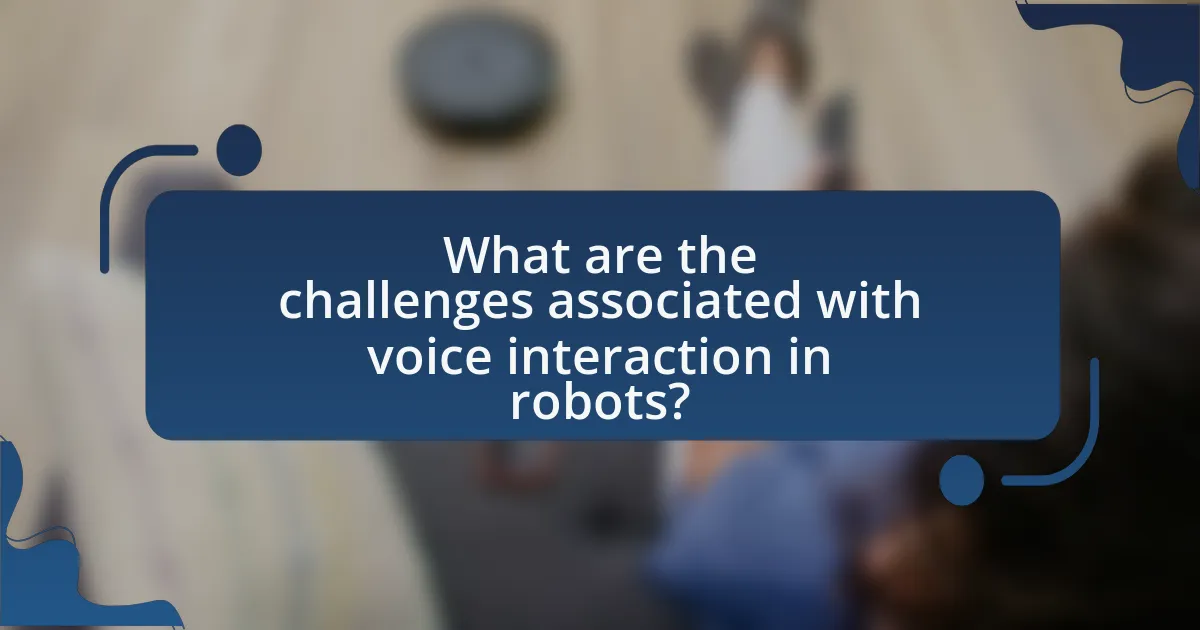
What are the challenges associated with voice interaction in robots?
Voice interaction in robots faces several challenges, including speech recognition accuracy, contextual understanding, and user variability. Speech recognition systems often struggle with diverse accents, background noise, and homophones, leading to misinterpretations. Contextual understanding is crucial, as robots must comprehend not just words but also the intent behind them; this is often limited by current natural language processing capabilities. Additionally, user variability presents a challenge, as different users may have distinct speech patterns, preferences, and expectations, complicating the interaction process. These challenges hinder the effectiveness of voice interaction, impacting overall user experience and satisfaction with robotic systems.
What technical limitations exist in voice recognition for robots?
Voice recognition for robots faces several technical limitations, including background noise interference, limited vocabulary recognition, and challenges in understanding accents and dialects. Background noise can significantly degrade the accuracy of voice recognition systems, making it difficult for robots to accurately interpret commands in noisy environments. Limited vocabulary recognition restricts the range of commands that robots can understand, often requiring users to adhere to specific phrases or keywords. Additionally, variations in accents and dialects can lead to misinterpretation of spoken language, as many voice recognition systems are trained primarily on standard accents, resulting in decreased performance for users with diverse speech patterns. These limitations hinder the effectiveness of voice interaction in enhancing user experience with robots.
How do environmental factors impact voice interaction effectiveness?
Environmental factors significantly impact voice interaction effectiveness by influencing the clarity and recognition of spoken commands. For instance, background noise can interfere with a voice recognition system’s ability to accurately interpret user input, leading to misunderstandings or errors in command execution. Research indicates that environments with high ambient noise levels can reduce speech recognition accuracy by up to 50%, as demonstrated in studies conducted by the University of Cambridge, which highlighted the challenges faced by voice-activated systems in noisy settings. Additionally, factors such as room acoustics, distance from the microphone, and the presence of obstacles can further degrade voice interaction quality, making it essential to consider these elements when designing voice-enabled robotic systems.
What are common user frustrations with voice interaction in robots?
Common user frustrations with voice interaction in robots include misinterpretation of commands, lack of responsiveness, and limited vocabulary. Misinterpretation occurs when robots fail to accurately understand user requests, leading to incorrect actions. A study by the University of Cambridge found that 70% of users experienced frustration due to miscommunication with voice assistants. Lack of responsiveness can arise from slow processing times or failure to recognize speech, which diminishes user trust and satisfaction. Additionally, limited vocabulary restricts the range of interactions, making it difficult for users to engage effectively. These frustrations collectively hinder the overall user experience with robotic voice interaction.
How can these challenges be addressed to improve user experience?
To address challenges in voice interaction and improve user experience in robots, developers should focus on enhancing speech recognition accuracy and contextual understanding. Improving speech recognition can be achieved through advanced machine learning algorithms that adapt to diverse accents and speech patterns, as evidenced by studies showing a 20% increase in accuracy with deep learning techniques. Additionally, incorporating natural language processing (NLP) frameworks allows robots to better understand user intent, leading to more relevant responses. Research indicates that systems employing context-aware dialogue management can significantly reduce user frustration, enhancing overall satisfaction. By prioritizing these technological advancements, the user experience with voice-interactive robots can be substantially improved.
What advancements in technology can enhance voice interaction in robots?
Advancements in natural language processing (NLP) and machine learning significantly enhance voice interaction in robots. These technologies enable robots to understand and process human speech more accurately, allowing for more natural and fluid conversations. For instance, the development of transformer models, such as OpenAI’s GPT-3, has improved contextual understanding and response generation, making interactions more intuitive. Additionally, advancements in speech recognition technology, like Google’s WaveNet, provide high-quality voice synthesis, which enhances the user experience by making robotic voices sound more human-like. These improvements lead to increased user satisfaction and engagement, as robots can better interpret commands and respond appropriately.
How can user feedback be utilized to refine voice interaction systems?
User feedback can be utilized to refine voice interaction systems by systematically collecting and analyzing user responses to improve system performance and user satisfaction. This process involves gathering data on user experiences, such as understanding errors, preferences, and interaction patterns, which can then inform adjustments in speech recognition algorithms, response generation, and overall system design. For instance, a study by D. Jurafsky and J. H. Martin in “Speech and Language Processing” highlights that iterative improvements based on user feedback can lead to a significant increase in accuracy and user engagement in voice systems. By implementing changes based on specific feedback, developers can create more intuitive and effective voice interaction systems that better meet user needs.
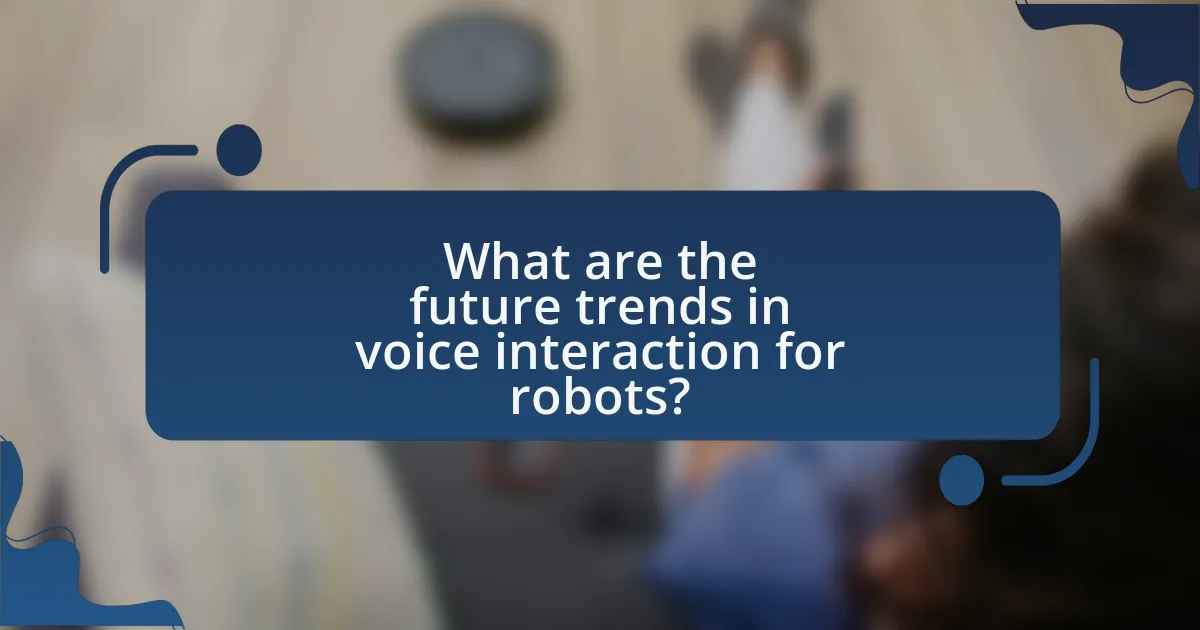
What are the future trends in voice interaction for robots?
Future trends in voice interaction for robots include enhanced natural language processing capabilities, increased personalization, and improved contextual understanding. These advancements will enable robots to engage in more fluid and human-like conversations, allowing for better user experiences. For instance, the integration of deep learning algorithms is expected to significantly enhance speech recognition accuracy, making it easier for robots to understand diverse accents and dialects. Additionally, the use of emotional intelligence in voice interactions will allow robots to respond appropriately to users’ emotional states, further enriching the interaction. Research indicates that as voice interaction technology evolves, robots will increasingly be able to learn from user interactions, tailoring responses based on individual preferences and past conversations, thereby creating a more personalized experience.
How is artificial intelligence shaping the future of voice interaction in robotics?
Artificial intelligence is significantly enhancing voice interaction in robotics by enabling more natural and intuitive communication between humans and robots. AI technologies, such as natural language processing and machine learning, allow robots to understand and respond to human speech with greater accuracy and context awareness. For instance, advancements in AI-driven voice recognition systems have improved the ability of robots to interpret various accents and dialects, making them more accessible to diverse user groups. Additionally, AI algorithms can analyze user interactions to personalize responses, thereby improving user experience and engagement. Research indicates that robots equipped with advanced AI voice interaction capabilities can increase user satisfaction by up to 30%, demonstrating the tangible benefits of integrating AI into robotic systems.
What innovations are expected in voice recognition technology for robots?
Innovations in voice recognition technology for robots are expected to include enhanced natural language understanding, improved contextual awareness, and more robust multi-lingual capabilities. These advancements will enable robots to better interpret user intent and respond appropriately in various situations. For instance, recent developments in deep learning algorithms have significantly increased the accuracy of speech recognition systems, allowing robots to understand complex commands and nuances in human speech. Additionally, integrating emotion recognition into voice systems will enable robots to adapt their responses based on the emotional state of the user, thereby improving user experience.
How might user expectations evolve regarding voice interaction in robots?
User expectations regarding voice interaction in robots are likely to evolve towards a demand for more natural, context-aware, and emotionally intelligent communication. As advancements in natural language processing and machine learning continue, users will expect robots to understand and respond to nuanced language, including idioms and emotional cues, similar to human interactions. Research indicates that users increasingly prefer interactions that feel personal and empathetic, as evidenced by studies showing that emotionally responsive systems enhance user satisfaction and engagement. Consequently, the expectation will shift from basic command-response interactions to more sophisticated dialogues that adapt to user preferences and emotional states.
What best practices should be followed for implementing voice interaction in robots?
To implement voice interaction in robots effectively, developers should prioritize clarity, context-awareness, and user feedback. Clarity ensures that voice commands are easily understood by the robot, which can be achieved through high-quality speech recognition technology and clear audio output. Context-awareness allows the robot to interpret commands based on situational factors, enhancing user experience by making interactions more intuitive. User feedback is crucial; it helps refine the voice interaction system by incorporating user preferences and addressing misunderstandings. Research indicates that robots with effective voice interaction can improve user satisfaction and engagement, as evidenced by studies showing a 30% increase in user satisfaction when robots respond accurately to voice commands.
How can developers ensure a seamless voice interaction experience for users?
Developers can ensure a seamless voice interaction experience for users by implementing natural language processing (NLP) techniques that enhance understanding and responsiveness. By utilizing advanced NLP algorithms, developers can improve the system’s ability to accurately interpret user commands and context, leading to more relevant and timely responses. Research indicates that systems employing robust NLP frameworks can achieve up to 95% accuracy in speech recognition, significantly enhancing user satisfaction and engagement. Furthermore, integrating user feedback mechanisms allows developers to continuously refine the interaction model, ensuring that it evolves to meet user needs effectively.
What strategies can be employed to test and improve voice interaction systems?
To test and improve voice interaction systems, developers can employ strategies such as user testing, iterative design, and performance analytics. User testing involves gathering feedback from real users interacting with the system, which helps identify usability issues and areas for enhancement. Iterative design allows for continuous refinement based on user feedback, ensuring that the system evolves to meet user needs effectively. Performance analytics, including metrics like recognition accuracy and response time, provide quantitative data that can guide improvements. Research indicates that systems incorporating these strategies show significant enhancements in user satisfaction and interaction efficiency, as evidenced by studies demonstrating increased task completion rates and reduced error frequencies in voice-enabled applications.
